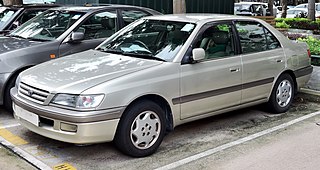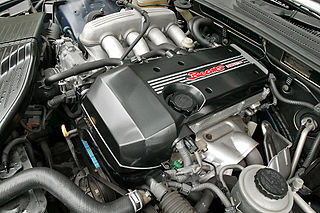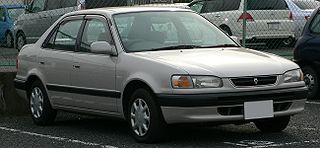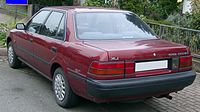
The Toyota Celica is an automobile produced by Toyota from 1970 until 2006. The Celica name derives from the Latin word coelica meaning heavenly or celestial. In Japan, the Celica was exclusive to the Toyota Corolla Store dealer chain. Produced across seven generations, the Celica was powered by various four-cylinder engines, and bodystyles included convertibles, liftbacks, coupés and notchback coupés.

The Vauxhall Cavalier is a large family car that was sold primarily in the United Kingdom by Vauxhall from 1975 to 1995. It was based on a succession of Opel designs throughout its production life, during which it was built in three incarnations. The first generation of Cavalier, launched in 1975 and produced until 1981, was Vauxhall's version of the General Motors 'U-Car' - essentially an Opel Ascona B/ Opel Manta with a few minor visual differences.

The Peugeot 205 is a supermini (B-segment) car produced by the French manufacturer Peugeot from 1983 to 1999.

The Toyota Avensis is a mid-size/large family car built in Derbyshire, United Kingdom by the Japanese automaker Toyota from October 1997 to August 2018. It was the direct successor to the European Carina E and was available as a four-door saloon, five-door liftback and estate.

The Toyota A Series engines are a family of inline-four internal combustion engines with displacement from 1.3 L to 1.8 L produced by Toyota Motor Corporation. The series has cast iron engine blocks and aluminum cylinder heads. To make the engine as short as possible, the cylinders are siamesed.

The Toyota Corona is an automobile manufactured by the Japanese automaker Toyota across eleven generations between 1957 and 2001. On launch, the Corona was Toyota's second-highest product in their range, just below the Crown. The Corona was marketed in the JDM at Toyota's Toyopet Store dealership channels, and the Corona was one of Toyota's first models exported to other global markets, followed by the smaller Toyota Corolla.

The Toyota Sprinter is a compact car manufactured by Toyota as a variant of the Toyota Corolla. Exclusively sold in the Japanese domestic market, the Sprinter was aimed to be sportier than its Corolla sibling and also using different sheet metal mostly on the C-pillar. The Sprinter was sold exclusively at the Toyota Auto Store while the Corolla was sold at the eponymous Toyota Corolla Store, which focused on economical cars compared to the more upmarket Vista store.

The Toyota R family was a series of inline-four gasoline automobile engines. Designed for longitudinal placement in such vehicles as the Celica and Hilux and in production from 1953 through 1997, usage faded out as many of Toyota's mainstream models moved to front-wheel drive. Overhead cam (OHC) versions featured a chain-driven camshaft.

The Toyota Mark II is a compact, later mid-size sedan manufactured and marketed in Japan by Toyota between 1968 and 2004. Prior to 1972, the model was marketed as the Toyota Corona Mark II. In some export markets, Toyota marketed the vehicle as the Toyota Cressida between 1976 and 1992 across four generations. Toyota replaced the rear-wheel-drive Cressida in North America with the front-wheel-drive Avalon. Every Mark II and Cressida was manufactured at the Motomachi plant at Toyota, Aichi, Japan from September 1968 to October 1993, and later at Toyota Motor Kyushu's Miyata plant from December 1992 to October 2000, with some models also assembled in Jakarta, Indonesia as the Cressida.

The Honda Concerto is a car produced from 1988 to 1996. Designed to aim at European tastes, it was jointly developed by Honda and the Austin Rover Group and was introduced in Japan on 15 June 1988, and in European markets in October 1989. Japanese production finished in October 1992 and British production finished in 1995. The car was named for the musical composition and was a successor to the second generation Honda Ballade, a higher specification Honda Civic. All Japanese versions were exclusive to Japanese Honda dealerships called Honda Clio.

The Toyota Carina is an automobile which was manufactured by Toyota from December 1970 to December 2001. It was introduced as a sedan counterpart of the Celica, with which it originally shared a platform. Later, it was realigned to the Corona platform, but retained its performance image, with distinctive bodywork and interior — aimed at the youth market and remaining exclusive to Japanese Toyota dealerships Toyota Store. It was replaced in Japan by the Toyota Allion in 2001 and succeeded in Europe by the Toyota Avensis.

The Toyota Caldina is an automobile manufactured by Toyota for the Japanese market from 1992 to 2007. It replaced the Corona and Carina wagons, and was sold at Toyota Store and Toyopet Store locations in Japan. While the Caldina has never been officially exported by Toyota, its All-Trac 4WD capability and large capacity have made it a popular grey import in Australia, New Zealand, Russia and many South American countries. When it was discontinued in 2007, the T270 series Avensis wagon/estate assumed its market position.

The Toyota S Series engines are a family of straight-four petrol engines with displacements between 1.8 and 2.2 litres, produced by Toyota Motor Corporation from January 1980 to August 2007. The S series has cast iron engine blocks and aluminium cylinder heads.

The Volkswagen Taro 1 tonne pickup truck was introduced in January 1989 by Volkswagen Commercial Vehicles to complement the half tonne Caddy pickup / panel van ranges, and the 1 tonne Transporter van and chassis cab ranges. The name "tarō" is a suffix used in Japanese to denote the oldest brother or son, or the first-born son of a family.

The Corolla E90, introduced in 1987 for the 1988 model year, was the sixth generation of cars sold by Toyota under the Corolla nameplate. It was the last generation of Corolla to be classified as a subcompact car and the first to be exclusively front-wheel drive or all-wheel drive; the performance option of rear-wheel drive was dropped.

The Corolla E100 was the seventh generation of cars sold by Toyota under the Corolla nameplate. This generation of Corolla was larger, heavier, and visually more aerodynamic than the model it replaced. With its 2,465 mm (97.0 in) wheelbase, the Corolla had moved into the compact size class once occupied by the Corona and Camry. The Corolla again had an equivalent model Sprinter, with the Sprinter Trueno being equivalent to the Corolla Levin and both exclusive to Toyota Vista Store Japanese dealerships.

The Corolla E110 was the eighth generation of cars sold by Toyota under the Corolla nameplate.

The Toyota Corolla E80 is a range of small automobiles manufactured and marketed by Toyota from 1983 to 1987 as the fifth generation of cars under the Corolla and Toyota Sprinter nameplates, with production totaling approximately 3.3 million, and most models adopting a front-wheel drive layout.
The ToyotaC engine family was a series of inline-4 diesel engines. There were two earlier generations of an engine Toyota named as the "Type C". The first generation was introduced in 1940 as a modification of the Type A engine. This first "Type C" was installed in the Toyota AE. The second generation was the first diesel engine at 1500cc used in the CS20 series 1959 Toyota Crown in October 1959. Japanese market vehicles with diesel engines were exclusive to Toyota Japan dealerships called Toyota Diesel Shop locations from 1979 until the dealership was cancelled in 1988.

The Toyota Sprinter Trueno is a series of compact sports coupés and hot hatches which were produced by Toyota from 1972 to 2000. The name Trueno in Spanish means thunder. In Japan, the Sprinter Trueno was exclusive to Toyota Auto Store locations, later renamed Toyota Vista Store in 1980.




























